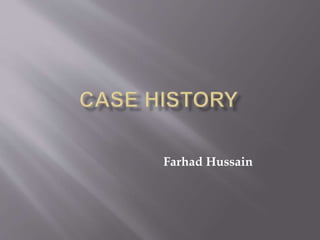
Case history cp angle
- 2. 55 years old female, married with 3 kids, resident of Quetta, came to OPD with complain of: Decreased Hearing in Right ear for 10 years
- 3. According to patient she was alright 1year ago, then she noticed hearing from right ear, it has insidious onset and slowly progressing, she had no headache, vertigo, vomitings, or difficulty in walk, swallowing , aspiration or hoarseness.
- 4. HTN for 10years on tab norvasc, 5mg. Had Lap Cholecystectomy 15 years ago. Family HX: Mother Had DM, and she died of Breast Ca. Socioeconomic status: Middle class family.
- 5. Personal Hx: Normal sleep, bowel habits are normal, decreased appetite.
- 6. 55 years old female with anxious look, sitting on bed comfortably, well oriented to time, place and person. Vitally – stable Systemic examination – unremarkable
- 7. HMF – Intact Upper and lower examination: Motor – intact Sensory – intact Cranial Nerve Exam : Normal except for 8th , Air conduction was more than Bone conduction in both ears, Weber’s test lateralized to left ear.
- 8. Base Line workup – Normal MRI Brain with contrast
- 10. 1- Vestibular schwannoma (VS) (most common 92%). 2- CPA meningiomas (second most common 3– 7%). 3- Epidermoid cyst (2–6%). 4- Trigeminal schwannoma. 5- Facial schwannoma.
- 11. Clinical Presentation: Unilateral sensory neural hearing loss with high frequency and speech discrimination being the most affected. Tinnitus and dizziness are common but true vertigo is rare. If facial weakness then think of facial schwannoma.
- 12. VS may result into compression of the lower cranial nerves leading to difficulty in swallowing, aspiration or hoarseness. In very large VS the fourth ventricle can be obstructed leading to hydrocephalus, papilloedema and reduced level of consciousness.
- 13. Represent about 6% of all intracranial tumours. They are benign, slow growing tumours, which arise from Schwann-cells in the nerve sheath that surrounds the vestibular nerves. The incidence of VS is around 13 cases/ million/year. Moffat DA, Hardy DO, Baguley DM. Strategy and benefits of acoustic neuroma searching. J Laryngol Otol 1999; 103: 51–59 The median age at diagnosis is approximately 50 years. Propp JM, McCarthy BJ, Davis FG et al. Descriptive epidemiology of vestibular schwannomas. Neuro- oncol 2006; 8: 1–11.
- 14. The tumours are unilateral in more than 90%,affecting the right and left sides with equal frequency. Edwards CG, Schwartzbaum JA, Lonn S et al. Exposure to loud noise and risk of acoustic neuroma. Am J Epidemiol 2006; 163: 327–333
- 15. The vast majority of VS are sporadic and unilateral in more than 90%. Bilateral vestibular schwannomas are primarily limited to patients with autosomal dominant neurofibromatosis (NFII).
- 16. Slow growing tumours These tumours are slow growing and may shrink in size spontaneously. Some authors recommended an initial one year radiological surveillance in all small VS and if they grew in the first year they were treated. O’Reilly B, Murray CD, Hadley DM. The conservative management of acoustic neuroma: a review of forty-four patients with magnetic resonance imaging. Clin Otolaryngol 1999; 25: 82–86 Others recommended that surveillance should be abandoned in favour of intervention if the tumour grew by 2 mm in the first year. Smouha EE, Yoo M, Mohr K et al. Conservative management of acousticneuroma: a meta analysis and proposed treatment algorithm. Laryngoscope 2005; 115(3): 450–454
- 18. Conservative: Radiological survillence if small as VS are slow growing tumors. Surveillance should be abondoned by tumor grow by 2mm in first year. Some suggest intervention if tumor size is 15mm or bigger.
- 19. Microsurgery: Recommended for tumors more than 3cm in size and in the presence of brain stem compression and hydrocephalus. Surgical approaches vary as per tumor pathological involvement. While complete excision is planned for most cases, the intimate involvement of surrounding structures may impose unwarranted morbidity if complete excision is attempted.
- 20. Translabyrinthine Suboccipital (retrosigmoid = RS) Middle fossa (MCF) craniotomies The choice of approach is based on specific location and hearing status
- 21. If one of the goals of surgery was to preserve hearing then the retrosigmoid (RS) or middle cranial fossa (MCF) approaches would be preferred. If the VS was mainly in the CPA, the RS approach would be preferable and for intracanalicular VS the MCF approach would be preferred. The RS approach is the only one that enables hearing preservation regardless of tumour size.
- 22. SRS had become a universally accepted treatment option for small VS (< 3 cm in diameter). 94% tumour control rate, 77% normal facial preservation rate and 51% hearing preservation rate was reported with SRS Kondziolka D, Lunsford LD, McLaughlin MR et al. Long-term outcomes after radiosurgery for acoustic neuromas. N Engl J Med 1998; 339: 1426–1433.
